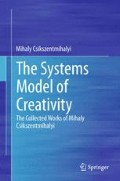Abstract
Creativity has become such a commonly used term in the past few decades that everyone has formed an opinion about what it means, and there is no need to define it further. In this chapter, however, we are going to use the word in specific ways, so a few words of explanation may be useful to orient the reader. There are three main dichotomies we use, and if these are not clear, what follows might be confusing.
“Reproduced with permission from Perspective” J. Nakamura and M. Csikszentmihalyi “Creativity through the Life Span from an Evolutionary Systems in C. Hoare (Ed.) Handbook of Adult Development and Learning. New York: Oxford University Press, 2006, pp 243−254. Copyright © 2006 Oxford University Press”. http://www.oup.com
Access this chapter
Tax calculation will be finalised at checkout
Purchases are for personal use only
References
Altmann, J. (1980). Baboon mothers and infants. Cambridge: Harvard University Press.
Anderson, S. R., & Ray, P. H. (2001). The cultural creatives. New York: Three Rivers Press.
Baltes, P. B., & Staudinger, U. (2000). Wisdom: A meta-heuristic (pragmatic) to orchestrate mind and virtue toward excellence. American Psychologist, 55, 122–136.
Blackmore, S. (1999). The meme machine. Oxford: Oxford University Press.
Brannigan, A. (1981). The social basis of scientific discoveries. New York: Cambridge University Press.
Bourdieu, P. (1993). The field of cultural production. New York: Columbia University Press.
Cattell, R. B. (1963) Theory of fluid and crystallized intelligence: A critical experiment. Journal of Educational Psychology, 54, 1–22.
Csikszentmihalyi, M. (1988). Society, culture, and person: A systems view of creativity. In R. J. Sternberg (Ed.), The nature of creativity: Contemporary psychological perspectives (pp. 325–339). New York: Cambridge University Press.
Csikszentmihalyi, M. (1993). The evolving self: A psychology for the third millennium. New York: HarperCollins.
Csikszentmihalyi, M. (1996). Creativity: Flow and the psychology of discovery and invention. New York: HarperCollins.
Csikszentmihalyi, M. (1998). Creativity and genius: A systems perspective. In A. Steptoe (Ed.), Genius and the mind (pp. 39–66). Oxford: Oxford University Press.
Csikszentmihalyi, M. (1999). Implications of a systems perspective for the study of creativity. In R. J. Sternberg (Ed.), Handbook of creativity (pp. 313–335). Cambridge: Cambridge University Press.
Csikszentmihalyi, M., & Wolfe, R. (2000). New conceptions and research approaches to creativity: Implications of a systems perspective for creativity in education. In K. A. Heller, F. J. Monks, R. J. Sternberg, R. Subornik (Eds.), International handbook of giftedness and talent (pp 81–93). Nailsea: Elsevier Science.
Dawkins, R. (1976). The selfish gene. New York: Oxford University Press.
Dennis, W. (1956). Age and achievement: A critique. Journal of Gerontology, 11, 331–333.
Dennis, W. (1966). Creative productivity between the ages of 20 and 80 years. Journal of Gerontology, 21, 1–18.
Dewey, J. (1934). Art as experience. New York: Minton, Balch.
Drucker, P. F. (1985). Innovation and entrepreneurship. New York: Harper Business.
Drucker, P. F. (1999). Management challenges for the 21st century. New York: Harper Business.
Estes, R. D. (1976). The significance of breeding synchrony in the wildebeest. East African Wildlife Journal, 14, 135–152.
Fagan, R. (1981). Animal play behavior. New York: Oxford University Press.
Florida, R. (2002). The rise of the creative class. New York: Basic Books.
Hull, D. L. (1988). Science as a process. Chicago: University of Chicago Press.
Kasof, J. (1995). Explaining creativity: The attributional perspective. Creativity Research Journal, 8(4), 311–366.
Kawai, M. (1965). Newly-acquired pre-cultural behavior of the natural troop of Japanese monkeys on Koshima Islet. Primates, 6(1), 1–30.
Kubey, R., & Csikszentmihalyi, M. (2002). Television addiction. Scientific American, 286(2), 74–81.
Kuhn, T. S. (1962). The structure of scientific revolutions. Chicago: University of Chicago Press.
Lehman, H. C. (1953). Age and achievement. Princeton: Princeton University Press.
Lehman, H. C. (1960). The age decrement in outstanding scientific creativity. American Psychologist, 15, 128–134.
MacKinnon, D. W. (1963). Creativity and images of the self. In R. W. White (Ed.), The study of lives. New York: Atherton.
Martindale, C. (1990). The clockwork muse: The predictability of artistic change. New York: Basic Books.
Miller, G. (2000). The mating mind: How sexual choices shaped the evolution of human nature. New York: Random House.
Nakamura, J., & Csikszentmihalyi, M. (2003). The motivational sources of creativity as viewed from the paradigm of positive psychology. In L. G. Aspinwall & U. M. Staudinger (Eds.), A psychology of human strengths (pp. 257–270). Washington, DC: American Psychological Association.
Reti, L. (Ed.). (1974). The unknown Leonardo. New York: McGraw Hill.
Schaie, K. W. (1996). Intellectual development in adulthood. In J. E. Birren & K. W. Schaie (Eds.), Handbook of the psychology of aging (4th ed., pp. 266–286). San Diego: Academic Press.
Simonton, D. K. (1999). Creativity from a historiometric perspective. In R. J. Sternberg (Ed.), Handbook of creativity (pp. 116–136). New York: Cambridge University Press.
Wali, K. C. (1991). Chandra. Chicago: University of Chicago Press.
White, J. P. (1968). Creativity and education: A philosophical analysis. British Journal of Educational Studies, 16, 123–137.
Wigner, E. (1992). The recollections of Eugene P. Wigner: Plenum Press.
Zuckerman, H., & Merton, R. K. (1972). Age, aging, and age structure in science. In M. W. Riley, M. Johnson, & A. Foner (Eds.), Aging and society (Vol. 3, pp. 292–356). New York: Russell Sage Foundation.
Author information
Authors and Affiliations
Corresponding author
Rights and permissions
Copyright information
© 2014 Springer Science+Business Media Dordrecht
About this chapter
Cite this chapter
Csikszentmihalyi, M., Nakamura, J. (2014). Creativity Through the Life Span from an Evolutionary Systems Perspective. In: The Systems Model of Creativity. Springer, Dordrecht. https://doi.org/10.1007/978-94-017-9085-7_15
Download citation
DOI: https://doi.org/10.1007/978-94-017-9085-7_15
Published:
Publisher Name: Springer, Dordrecht
Print ISBN: 978-94-017-9084-0
Online ISBN: 978-94-017-9085-7
eBook Packages: Behavioral ScienceBehavioral Science and Psychology (R0)

